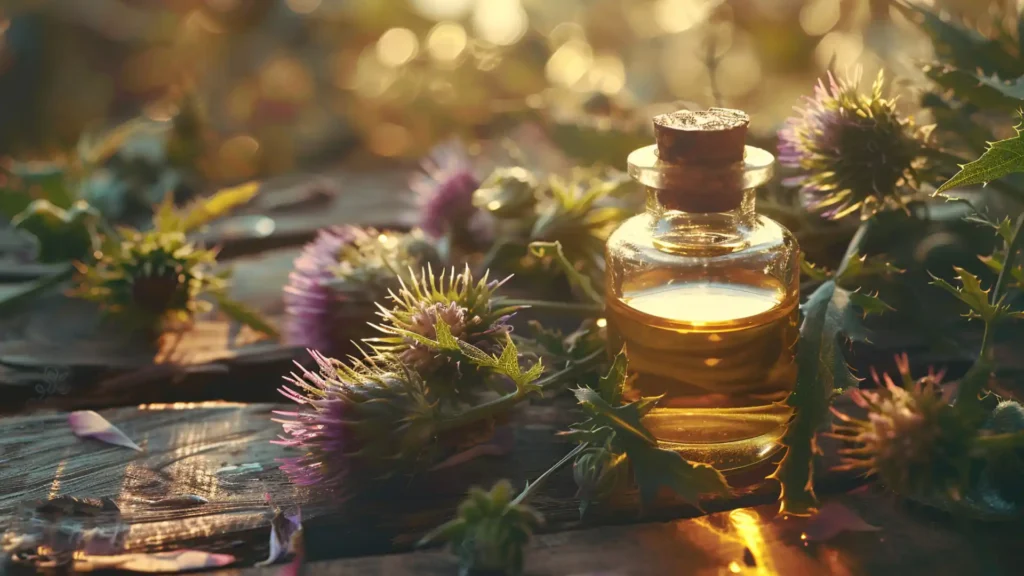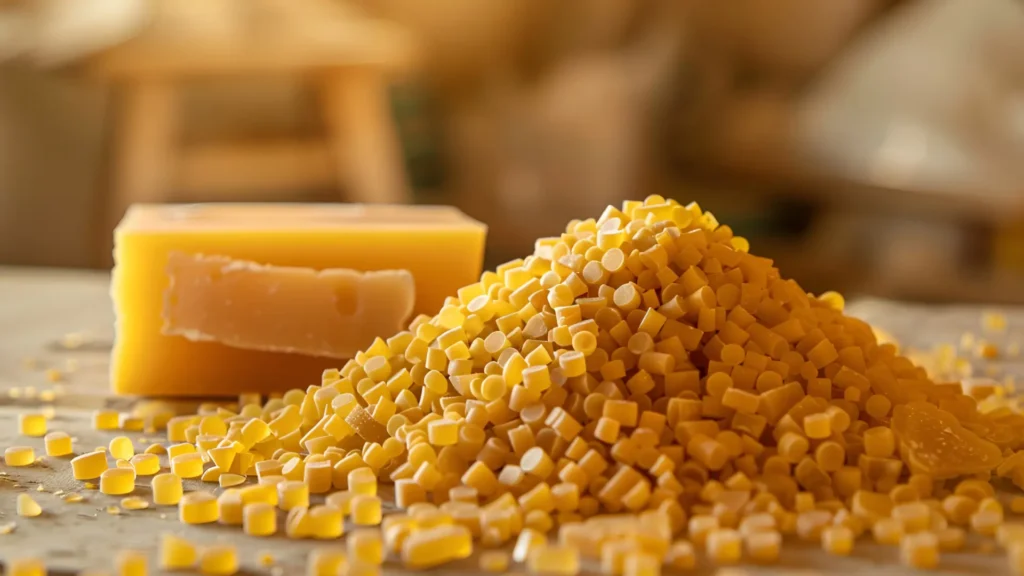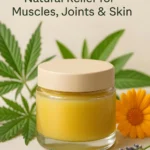There’s something special about creating your own Cannabis-infused skincare products. I mean, have you ever thought about unleashing your creativity in skincare formulation? It feels empowering to mix ingredients and customise them for your skin type. Plus, it’s a fantastic way to explore your artistic side. Why not turn self-care into an art form?
We all have unique skin. Why settle for one-size-fits-all products? Creating your own allows you to tailor everything to your needs. It’s like cooking; you wouldn’t eat the same dish every day. So, why apply the same products?
Table of Contents
*As an Amazon Associate, I earn from qualifying purchases
Understanding the Benefits of Natural Versus Synthetic Products
One big question is always “natural or synthetic”? Natural ingredients often have fewer side effects. They’re derived from plants and are generally gentler on the skin. They contain a variety of essential fatty acids, vitamins, and minerals that benefit your body.
Synthetic products, however, can sometimes provide more immediate results than natural alternatives. Also, in cosmetic formulations, many natural ingredients are unaffordable or unsustainable in their natural firm. Often, synthetic alternatives offer us more choices. Also, many synthetic alternatives are actually plant sourced in the first place.
Research suggests that while synthetic ingredients are effective, some people prefer the peace of mind that natural products provide. It’s a balancing act, and understanding both sides helps us make informed choices.
Understanding the Base of My Soothing Balm
Formulation:
Stage 1: (heat until melted)
- 50% herb-infused Thistle Oil
- 5% Beeswax
- 5% Cocoa Butter
Heat Stage 1 in a double boiler until the solids have melted. There’s no need to use a thermometer at all.
Stage 2: (room temperature)
- 30% Vegetable oil of your choice
- 9% Squalane
- 1% Essential oils of your choice.
100% Total
Method:
- Add the Stage 1 ingredients to a double boiler to melt. A double boiler consists of a heat-resistant container, such as a Pyrex or stainless steel jug, placed in a saucepan of boiling water. The ingredients go into the heat-proof container and the boiling water safely transfers heat to the ingredients. The double boiler ensures the ingredients cannot overheat or burn. Leave them until they are all melted, then take the heat-proof container out.
- Let the Stage 1 ingredients cool until the edges become opaque, then stir in the Stage 2 ingredients. While the balm is still gloopy, pour it into your containers to set up.
How To Make Herb-Infused Oil
Herb-infused oil is a heat-stable oil that has dried herbs mixed in to steep over time. This is called a maceration. There are certain key parts to consider.
Most importantly, the herb needs to be dried. If you were to use fresh herb, the water content can cause spoilage which then leads to contamination.
A simple example can be dried Calendula flowers added to a mason jar and covered in Sweet Almond oil. Give the jar a shake every day and leave it on a sunny windowsill for a few weeks. When ready, strain it through a cheesecloth and put it in a bottle. Label it as Calendula oil and store it in a dark cupboard. It should be good for up to 1 year.
I prefer to use the POT by NOIDS as it is the easiest and most effective way to Make Herb and Cannabis-Infused Oils.
The instructions are the same for infusing cannabis. The cannabis must be dry, but it does not need to be ground up. Here are 10 Cannabis Strains that you could consider infusing.
Whether using just a herb or cannabis and other herbs, a good starting point is 1g of the dried plant and add 100g of heat-stable vegetable oil.
Note: If, after several months, the infused oil smells acrid or like old crayons, it’s probably rancid and should be discarded. This is another reason to make your infused oils in small batches.
Ingredients Focus
Let’s go into some more detail about the individual ingredients so you can see that every ingredient serves a useful and beneficial purpose.
Thistle Oil (Safflower oil)
Thistle oil, often overlooked, has a treasure trove of benefits for our skin. Have you ever wondered why it’s gaining popularity in skincare? Well, it’s primarily because of its rich content of essential fatty acids, antioxidants, and vitamins.

It may be more familiar to you as Safflower, but in the UK, aromatherapists and herbalists have always referred to it as Thistle oil.
- Firstly, Thistle oil is known for its ability to hydrate and soothe the skin. Its Linoleic acid content (Omega-6) helps maintain the skin’s moisture barrier, preventing dryness and irritation. This makes it an ideal ingredient for those with sensitive or inflamed skin.
- Your body can utilise Thistle oil to produce Gamma-Linolenic Acid (GLA). This is really important for your body to be able to repair itself. GLA is found in Evening Primrose oil and Borage oil, but both are costly and not heat stable.
- Thistle oil also has anti-inflammatory properties. It can help calm redness and puffiness. Using it in my soothing balm ensures that your skin feels relaxed and refreshed. And let’s not forget its role in promoting skin elasticity. With regular use, it can contribute to a firmer, plumper appearance for your skin.
- Another exciting aspect of Thistle oil is its heat stability. Not all oils can handle heat well, which causes oxidation and rancidity. This also damages your skin and increases the visible signs of ageing. Thistle oil, however, remains stable. This means it can withstand high temperatures for infusions while still helping your body to naturally produce its own GLA. Therefore, any balm containing Thistle oil is inherently a healing balm.
Beeswax
Beeswax is a natural substance produced by the glands of honey bees. It’s what bees use to build their honeycombs. Beeswax will not penetrate your skin and has no direct benefits for your skin. It does however, lock in moisture and allow the other ingredients to be kept close to the skin where they can penetrate and work their magic.

While beeswax is remarkable, it’s not the only option out there. Some folks prefer alternatives such as:
- Candelilla Wax: Derived from the leaves of the candelilla plant, it’s a great vegan substitute. It has a similar texture to beeswax but comes from a plant source!
- Rice Bran Wax: Extracted from Rice Bran oil, this wax is another excellent vegan alternative. It is often used in cosmetics.
What are the benefits of using these alternatives? Maybe you’re allergic to beeswax, or perhaps you adhere strictly to a vegan lifestyle. Understanding your options helps us make informed decisions.
Cocoa Butter
This exquisite natural fat has an enchanting aroma that is simply irresistible! It is the same ingredient that top-class chocolatiers use in their chocolates. It is also an amazing emollient, which means it keeps your skin supple.

It is very rejuvenating for skin that is dry and even skin with scars. Many pregnant women use it throughout their pregnancy to prevent stretch marks from even starting. You can learn more about the amazing skincare benefits of Cocoa Butter.
For everyday hand care alongside balms, listen to the Calendula Hand Cream recipe.
Extra Vegetable Oil
I don’t want this stage to confuse you. There needs to e a certain volume of total oils to make this formulation work properly. Thistle oil is the first to be used because it is heat-stable and is so beneficial for your skin.
If you wanted to, the Vegetable Oils of your choice stage, could still be Thistle oil, and you would add it all together. Using extra oil at a separate cooling stage allows you to use highly potent oils that aren’t stable at high temperatures. That means that they cannot be used to make infused oils because the heat would damage them.
These oils tend to be rich in Omega-3 essential fatty acid (Alpha-Linolenic Acid) which is a powerful skin repair agent. Oils to consider would be Rosehip Seed oil, Kiwi Seed oil, Borage oil, or Chia Seed oil. Maybe even a blend of some of them?
Squalane
This is one ingredient you need to make sure that you get the correct form. Generally, it is available as Squalene from shark livers. The firm I prefer to use is Squalane, which is sourced from olives. It mimics your skin’s natural sebum, transforming any balm into a silky luxury that absorbs well, leaving your skin smooth and supple. You can read a lot more about Squalane in this blog post: Making Your Own Squalane Cleanser.

Essential Oils
This is the icing on the cake. You can choose to not use essential oils if you want a fragrance-free product. Having said that, there will still be the natural fragrance of Beeswax and Cocoa Butter coming through, which is delightful.
Choosing the right essential oils can add so much extra therapeutic value to your balm.
- For Muscular Pain Relief: Use 20 drops of Plai essential oil.
- For Cooling Joint Pain Relief: Use 10 drops of Wintergreen oil with 10 drops of Peppermint oil.
- For Anti-Inflammatory Effects: Use 8 drops Roman Chamomile oil with 8 drops of Frankincense oil and 4 drops of Thyme oil.
- For Aching Feet: Combine 7 drops Lavender, 7 drops Eucalyptus and 6 drops Marjoram oils.
You can read more about the different Benefits of Essential Oils.
Importance of Accurate Measurements and Ratios
Now, let’s talk about something crucial: accurate measurements. Why is this so significant? Imagine baking a cake without measuring ingredients. What happens? The result can be a disaster! The same principle applies to creating skincare products.
Every ingredient has its unique properties. If we mismeasure, we risk altering the product’s effectiveness. For example, using too much Cocoa Butter can make the balm greasy and harder, making it difficult to apply. Therefore, maintaining the right ratios is key to achieving the intended benefits.
- Accurate ratios enhance the texture of the balm.
- Achieving the perfect balance enhances the soothing properties.
- Consistency ensures repeatable, reliable results.
When crafting my soothing balm, I always use a digital scale. Everything (even the oils) are weighed. This allows me to ensure precision with every batch. It’s a small step that makes a significant difference.
Conclusion
This soothing balm base is endlessly adaptable. Feel free to switch in your favorite vegetable oils, like Rosehip or Chia Seed, for some extra benefits. You can also add essential oils to match your specific needs! Try Lavender for relaxation, Peppermint for cooling, or Chamomile for calming. With this simple formula, you can create a balm tailored perfectly to you!
FAQ
What is a cannabis-infused soothing balm?
A cannabis-infused soothing balm is a topical product made with cannabis extracts, often combined with other natural ingredients, designed to calm, moisturise, and help relieve discomfort on the skin or muscles.
How does a cannabis balm work?
Cannabis balms work by delivering cannabinoids like CBD directly to the skin, where they interact with local receptors. This can help reduce inflammation, ease pain, and promote relaxation in the applied area without causing a high.
What can I use a cannabis soothing balm for?
You can use a cannabis-infused balm to ease muscle aches, joint discomfort, dry skin, and mild irritations. It’s also popular for soothing post-exercise soreness and calming inflamed areas.
Will a cannabis balm make me high?
No, applying a cannabis-infused balm will not make you high. These products work locally on the skin and muscles and do not enter the bloodstream in amounts that cause psychoactive effects.
Is it legal to use a cannabis-infused balm?
In most regions, topical balms with CBD or low levels of THC are legal, but it’s important to check your local laws before purchasing or using any cannabis skincare product.
How often can I use a cannabis soothing balm?
You can use the balm as often as needed, typically two or three times a day, or whenever you feel discomfort. Always follow the instructions on the label.
Are there any side effects from using cannabis balms?
Most people tolerate cannabis balms well, but it’s possible you might experience minor irritation or an allergic reaction. Always patch test on a small area first, especially if you have sensitive skin.
Can I use cannabis balm alongside other medications?
Generally, topical cannabis balms are considered safe with most medications, but if you have concerns or a specific health condition, it’s wise to speak to your doctor first.

If you liked this blog post, I would love it if you shared it with a friend.
If you use Pinterest, please pin this post.


